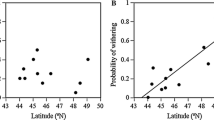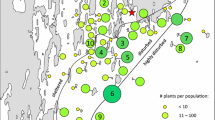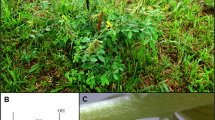Summary
Twelve Oklahoma populations of Cnidoscolus texanus were investigated for morphological variation between and within populations, and between site classes with contrasting histories of use by domesticated livestock. Characters scored were numbers of stinging hairs on petioles and midribs, and depth of leaf lobing. Leaf lobing was not significantly variable within or among populations or grazing categories. Stinging hair numbers showed significant differences within and among populations. Petiole stinging hairs were more numberous in heavily grazed sites, suggesting population differentiation in response to the selective pressures of herbivory.
Similar content being viewed by others
References
Barlow RB, Dixon ROD (1973) Choline acetyltranferase in the nettle Urtica dioica L. Biochem J 132: 15–18
Collier HOJ, Chesher GB (1956) Identification of 5-hydroxytryptamine in the sting of the nettle (Urtica dioica). Br J Pharmacol 11:186–189
Davis BNK (1983) Insects on nettles. Cambridge University Press, Cambridge
Dillon PM, Lowrie S, McKey D (1983) Disarming the “Evil Woman”: Petiole constriction by a sphingid larva circumvents mechanical defenses of its host plant, Cnidoscolus urens (Euphorbiaceae). Biotropica 15:112–116
Emmelin N, Feldberg W (1947) The mechanism of the sting of the common nettle (Urtica urens). J Physiol (London) 106:440–445
Jones DA (1971) Chemical defense mechanisms and genetic polymorphism. Science 173:945
Kolterman DA, Breckon GJ (1982) Chemotaxonomic studies in Cnidoscolus (Euphorbiaceae). I. Flavonol glycosides of the C. tubulosus complex. Syst Bot 7:178–185
Oelrichs PB, Robertson PA (1970) Purification of pain-producing substances from Dendrocnide (Laportea) morides. Toxicon 8:89–90
Pollard AJ, Briggs D (1982) Genecological studies of Urtica dioica L. I. The nature of intraspecific variation in U. dioica. New Phytol 92:453–470
Pollard AJ, Briggs D (1984) Genecological studies of Urtica dioica L. III. Stinging hairs and plant-herbivore interactions. New Phytol 97:507–522
SAS Institute Inc (1982) SAS User's Guide: Statistics. SAS Institute, Cary, North Carolina
Seigler DS, Bloomfield JJ (1969) Constituents of the genus Cnidoscolus. Phytochemistry 8:935
Thurston EL (1974) Morphology, fine structure, and ontogeny of the stinging emergence of Urtica dioica. Am J Bot 61:809–817
Thurston EL (1976) Morphology, fine structure and ontogeny of the stinging emergence of Tragia ramosa and T. saxicola (Euphorbiaceae). Am J Bot 63:710–718
Thurston EL, Lersten NR (1969) The morphology and toxicology of plant stinging hairs. Bot Rev 35:393–412
Willis CL (1969) Toxic constituents of the stinging nettle. M.S. Dissertation, Iowa State University, Ames, Iowa
Author information
Authors and Affiliations
Rights and permissions
About this article
Cite this article
Pollard, A.J. Variation in Cnidoscolus texanus in relation to herbivory. Oecologia 70, 411–413 (1986). https://doi.org/10.1007/BF00379504
Received:
Issue Date:
DOI: https://doi.org/10.1007/BF00379504




